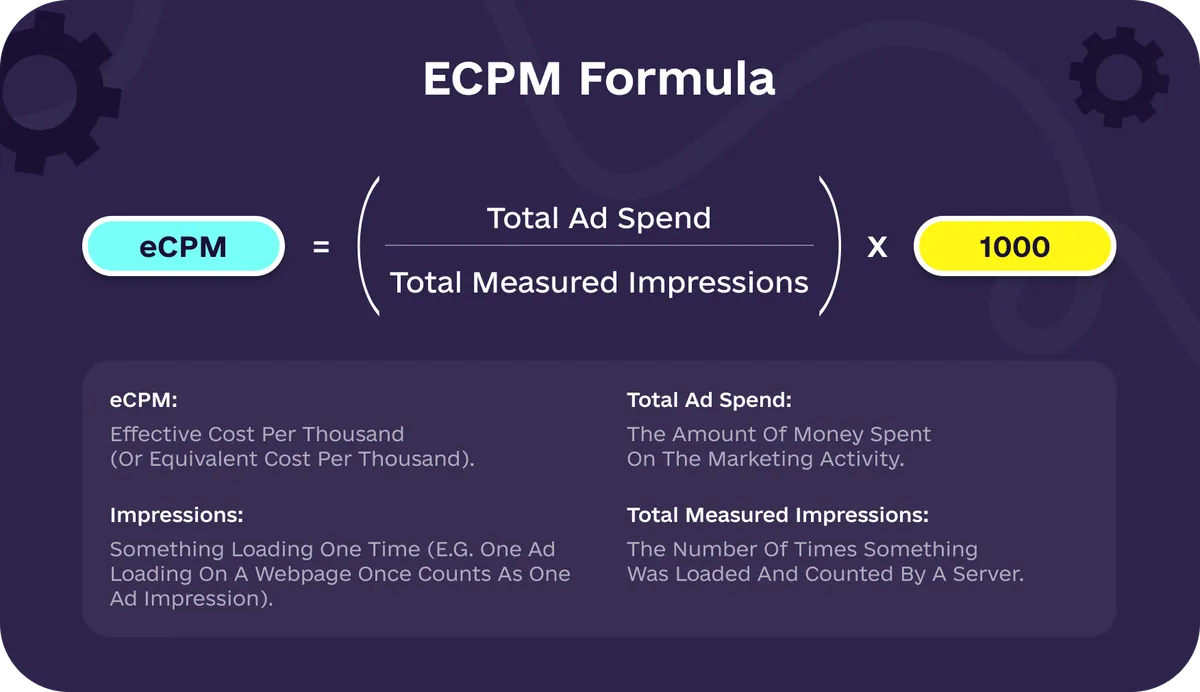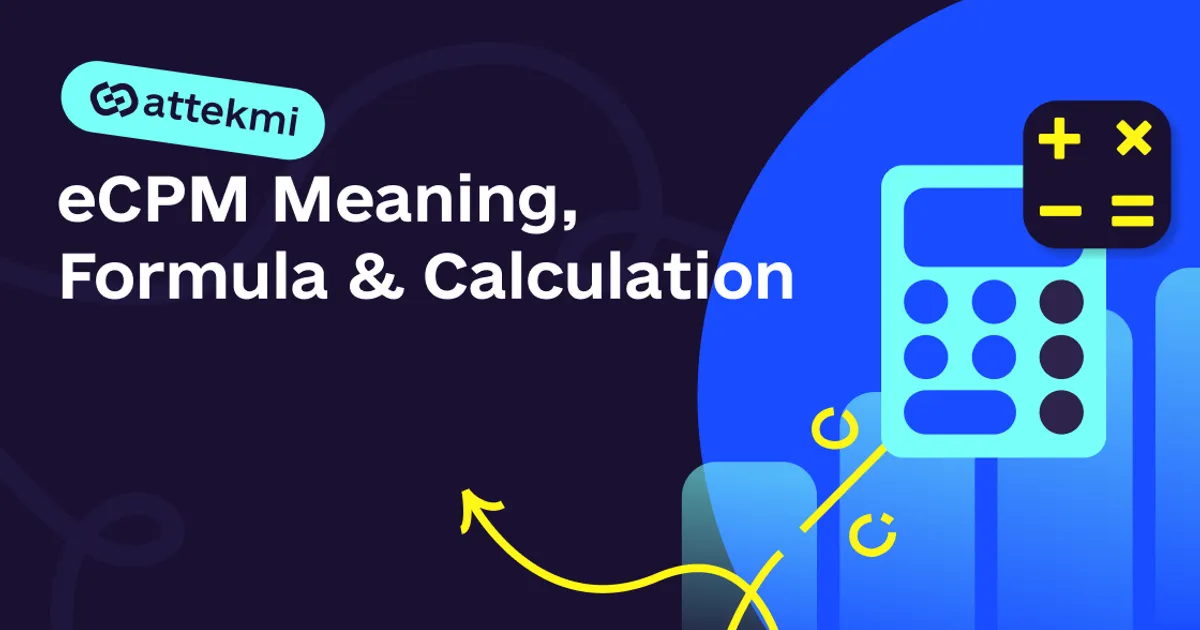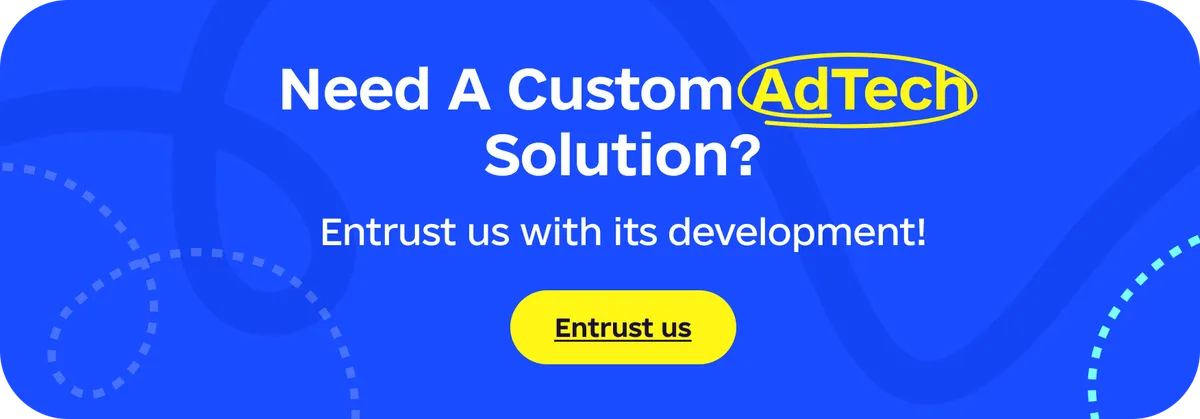Advertisers and publishers track an entire range of metrics to understand the performance of their campaigns and ad space. The eCPM marketing metric is on the list as well, and you, as an ad exchange owner, should also be aware of what it is and why it matters.
In this guide, we clarify the role of eCPM for publishers and advertisers, explain the formula for its calculation, and not only. Keep reading to learn more.
Key Takeaways
eCPM (effective cost per mille) measures revenue earned per 1,000 ad impressions and is crucial for both publishers optimizing monetization and advertisers evaluating campaign efficiency.
The eCPM formula is simple: (Revenue ÷ Impressions) × 1,000, and it helps compare performance across formats, placements, and partners.
Key factors influencing eCPM include ad format, targeting precision, placement visibility, seasonality, and audience engagement.
Publishers can boost eCPM by experimenting with formats, placements, SEO, and ensuring a strong user experience, while advertisers benefit from precise targeting and quality creatives.
Attekmi enables ad exchange owners to improve eCPM performance through multi-format support, traffic filtering, fraud detection, and adaptive margin strategies, helping partners like StreamKey double their profit in just 2 months.
What is eCPM?
eCPM stands for effective cost per mille and should not be confused with CPM, which is simply cost per mille (or cost per thousand impressions). In comparing eCPM VS CPM, eCPM is a metric indicating how much a thousand impressions earn.
Calculating eCPM is a must for publishers, as in this way, they understand how efficient and profitable the inventory is. Using this metric, they can ensure strategy and ad revenue optimization.
For marketers, CPM may seem to be a more important rate, as it measures the cost of delivering a thousand impressions. However, tracking eCPM allows them to understand the effectiveness of advertising campaigns. These insights can then be used for fine-tuning the campaigns and ads themselves.
One more term worth clarifying is the eCPM floor. Also known as a minimum eCPM or predefined CPM, it is the minimum acceptable price for purchasing ad space. If the bid is lower, it is automatically dismissed. In case it is above (or is equal to the eCPM floor), it joins the competition. Setting up a minimum eCPM can help publishers attract high-quality advertisers. However, if it is too high, marketers may prefer more budget-friendly options.
3 steps on how to calculate eCPM
In short, the eCPM formula is as follows: the ad revenue must be divided by the number of ad impressions and then multiplied by 1000. Now, let’s review an example of how to calculate eCPM.
Calculating the ad revenue
First of all, it is essential to measure total ad earnings. To do this, publishers multiply how much they earn per ad by the number of ad units they sell. For instance, the price of every unit is $3, and 100 of them were sold within a day. This means that the total revenue is $300.
As for advertisers, they can use the total ad spend instead of ad revenue.
Dividing the revenue
The next step is to divide the identified revenue by impressions. For example, 80k impressions were received during one day. Then, dividing $300 by 80,000 results in $0.00375.
Multiplying by 1000
Finally, the revenue per impression is multiplied by 1000 so publishers can figure out their revenue per thousand impressions. In our example, $0.00375 multiplied by 1000 is $3.75.
The formula is the same for publishers and advertisers; the only difference is that publishers use the ad revenue rate, while marketers use the amount of money they spent on a specific activity.
 To simplify the calculation process, publishers and advertisers can use an eCPM calculator.
To simplify the calculation process, publishers and advertisers can use an eCPM calculator.
What is a good eCPM?
If you try to google “what is a good ad eCPM?”, you will not find the exact numbers, only something like “on average, that is around $2-$10”. The thing is that the eCPM advertising metric differs from campaign to campaign (or from ad to ad). It is affected by an entire range of factors.
For instance, in comparison with banners, native ads often generate higher revenue since they are less intrusive. Therefore, for native ads, a good eCPM can be higher than for banner advertisements.
Here are the key factors to pay attention to when it comes to eCPM ads measurement.
Ad format
Different advertising formats may have different eCPMs. For instance, video ads may cost more than standard banner ads. Therefore, they will be more expensive for advertisers but more profitable for publishers.
Ad quality
High-quality ads, for instance, creative and memorable videos in high resolution, tend to be more appealing and engaging. They often have higher eCPMs than generic or low-quality advertisements.
Ad targeting
Precise targeting is key to effective advertising, so ads that are well-targeted and address specific audiences usually show better eCPM rates.
Ad placement
For publishers, it is also important to pay attention to the ad placement on their websites or apps, as ads that are easy to notice usually drive more income. For instance, these can be ads placed above the fold or pop-up advertisements.
Seasonality
Seasonality is another factor that can influence eCPM. For example, during holidays or special events like Black Friday, the competition for the publishers’ ad inventory often increases, which positively affects the eCPM rate.
Audience reach
Publishers that target niche audiences often have higher eCPMs than those addressing general audiences. This happens because advertising to specific customers is usually more expensive than promoting something to everyone.
User engagement
A website or app with a large base of loyal and engaged users usually has higher prices for ad inventory. As a result, its owner will earn more than publishers with low traffic.
Benefits of eCPM
As you already know, tracking the eCPM advertising metric is more important for publishers than for advertisers. However, marketers can monitor it as well to gain some actionable insights and, as a result, improve their strategies. For instance, ad placements with the highest eCPMs are usually prioritized, so they allow for greater visibility. If advertisers identify them, they may want to pay higher CPMs for these specific slots to reach their goals in a more effective way.
As for publishers, eCPM plays a crucial role for them, and here is why:
Effective monetization. Discovering which impressions drive the highest income has two benefits. First of all, publishers can adjust their strategies to prioritize this specific inventory. Secondly, they detect weak spots. For instance, low performance of a certain ad space may indicate poor placement or issues with the page design.
Identifying top advertisers. When eCPM is high, this means that a specific ad inventory delivers great performance and is appreciated by advertisers. Therefore, they are likely to use it again and be ready to invest more money in this ad space. For publishers, this means not only higher income but also an opportunity to build direct relationships with marketers who bring the highest value.
Revenue prediction. If a publisher measures eCPM regularly, they can compare the metric across months or even years. With this data in mind, they can predict future income and optimize the strategy accordingly.
Testing different formats. Comparing the eCPM rates for different ad slots enables publishers to check how different formats perform. The collected insights can then help attract the right marketers and optimize income.
Understanding the impact of changes. If a publisher decides to change anything in their website or app (for instance, design or content), measuring eCPM can help understand if these changes were the right thing to do. For example, if eCPM is decreasing, this means that the level of engagement is going down. Website or app changes can be the reason for this (although they are not the only option to consider).
Best practices for optimizing eCPM
Optimizing the eCPM rate is essential both for publishers and advertisers, so here are some recommendations for them to consider.
Join the programmatic ecosystem
Starting using a programmatic demand- or supply-side platform is one of the most effective ways for marketers and publishers to increase the eCPM rate. Applying multiple settings, advertisers can target exactly those users who are most likely to get interested in their ads. In turn, publishers deliver relevant advertisements to their visitors or users, which is good for their experience.
Experiment with formats and placements
It is also essential for marketers to try different ad formats, as some of them may drive better results than others. As for publishers, they should do the same, along with experimenting with ad placements. For instance, providing some ad space above the fold can lead to higher eCPMs.
Set up targeting
Advertisers also need to apply all the available targeting settings. Yes, the ads will reach smaller audiences, but these users will be more likely to convert.
Improve user experience
While advertisers should create high-quality ads, publishers need to ensure a good user experience. For example, it may be essential to increase the website speed or make it mobile-friendly. Besides, it is important to prioritize the quality of ads over their quantity.
Optimize for SEO
Publishers also need to optimize their websites for SEO to drive quality organic traffic. More visitors mean more opportunities, which will help increase eCPM.
Consider using Attekmi solutions
As an owner of an ad exchange, you need to assist publishers and advertisers in terms of optimizing their eCPMs, as this will have a positive impact on your income. With Attekmi solutions, this is simple since they come with the following features and opportunities:
The platform supports multiple traffic types, including desktop, in-app, mobile web, and CTV;
There are a variety of ad formats: banner, native, video, audio, pop, and CTV ads;
You can apply numerous filters and settings to match DSPs and SSPs effectively;
It is possible to integrate fraud detection tools for your SSP and DSP partners to ensure only genuine traffic, clicks, and impressions.
With Attekmi, you can start media trading quickly and maximize your revenue with the adaptive margin feature. For instance, StreamKey managed to double its profit within only two months.
In case you need a specific feature for driving higher eCPMs that is currently missing on the platform, feel free to opt for our White Label Ad Exchange, which is a fully custom platform.
To conclude
Publishers and advertisers aim for high eCPMs, so those who operate ad exchange solutions should do everything possible to help them. Obviously, you, as an ad exchange owner, cannot optimize the publisher’s website and make it mobile-friendly, but you can offer different ad formats and other features and match your supply and demand partners effectively. This way, you will make your solution attractive to marketers and publishers. They will be able to reach their goals, while your income will grow.
Note that there is no need to build an ad exchange from scratch – this is a time-consuming and expensive process. Instead, you can leverage a ready-to-use or a white-label solution that will start operating within a week or a bit more. This is the way to reduce production time and costs – you will start earning on media trading in the shortest time possible.
Try Attekmi solutions to ensure high eCPM rates for your publishers and advertisers!
FAQ
Here is the eCPM formula: the total advertising revenue (or ad spend for advertisers) is divided by the total number of ad impressions. Then, the result is multiplied by 1000. Using an effective cost per mille calculator is the way to simplify the calculation process.
A high eCPM means that ads are effective and drive conversions. Publishers earn more, while advertisers know that their ads are bringing results. To drive income, ad exchange owners have to provide both marketers and publishers with the conditions essential for reaching high eCPMs.
No, but you have to ensure that advertisers and publishers connecting via your platform can reach high eCPM rates. Set up endpoints for your SSP and DSP partners to match them effectively, ensure the variety of ad formats and traffic types, apply filters, and integrate fraud detection tools.
 By Anastasiia Lushyna
By Anastasiia Lushyna

